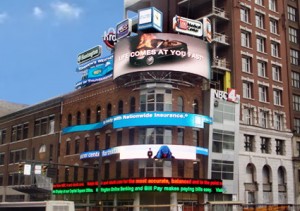Without a doubt, the importance of high-quality content for LED display spectaculars is a very hot topic as of late. Spectaculars are those gigantic, one-of-a-kind LED installations located in busy tourism and retail districts around the world – ‘Daktronics Lights Up Bucharest’s Cocor Luxury Store [1]‘ which we wrote about back in February 2009 is a good example, Ed
What makes them spectacular if you like are their size, dominance and, speaking as a manufacturer, the amount of custom engineering support that goes into each one!
In our experience at Daktronics we find content to be the most overlooked component of a successful LED display program – spectacular or otherwise. Las Vegas is a striking example of this. Spend some time walking the “the strip” and it quickly becomes apparent that a million-dollar screen can produce a negative brand impression if content is poorly produced. The customer-side impact of poor content is obvious. The impact it has on the industry and the public’s perception of large-screen LED technology is a bit more elusive.
But yet, there is more to this story. Many things need to come together to produce a successful LED spectacular. Skip any one of them and significant trouble (expense) is likely on the horizon. Here’s my take on the top four.
- Display Solution: this is the toughest part. Purchase from a reputable supplier and/or one that you personally trust. The display is likely to be the largest single investment of the system – so if you are going to do one thing right, make sure it is the display sourcing. If your organization is unfamiliar with LED displays, find someone to help you through the technology maze. Big ticket items like LED displays are often sold on a commission basis. This can sometimes lead to aggressive selling and “imaginative” technical presentations.
- Control Solution: some customers have one, so we’ll be expected to tie into it. Others do not, so we better have a solution for them. Either way, it is critical for companies like Daktronics to develop a clear understanding of what you want to accomplish and how you want to accomplish it: SD or HD? Standard or custom aspect ratio? Live real-time data feeds? Video or VGA/DVI (or both)? Split screen? Control locally or remotely? It is the responsibility of the solutions provider to ask all the questions, to cover all the details and to never assume the LED display is a stand-alone piece of equipment. The display may very well need to have its operations integrated with other LED and non-LED displays across the property.
- Content: Both of the above are wasted if the content falls short. It is more difficult today because any basement designer with a Mac and Adobe Creative Suite is now a “leading creative agency.” LED Spectaculars require a specialized approach to content production. Demand to see representative work and make a few reference calls. Great content isn’t so great when it shows up three or four weeks late.
- Support/Maintenance: EVERY LED display needs maintenance, as do the control systems that power them. Care to guess which one usually gets skipped? Display maintenance is usually not a significant investment. However, a display that does not see any maintenance will soon find itself degrading more quickly than others around it. Consider who you will call – and the service you might get – in the case of vandalism, an earthquake or “insert your disaster here.” Unfortunately, it happens more often than you might think.
It is hopefully easy to see how all of these are related to one another. While there are additional considerations that come into play – not the least of which is purchase price – making wise decisions in the above-listed areas greatly improves the odds of long-term success.
If you are considering an LED spectacular or billboard installation, begin by researching which LED suppliers can provide solutions across all these mission-critical areas (single-source approach) to avoid unnecessary frustration and expense in the future.
